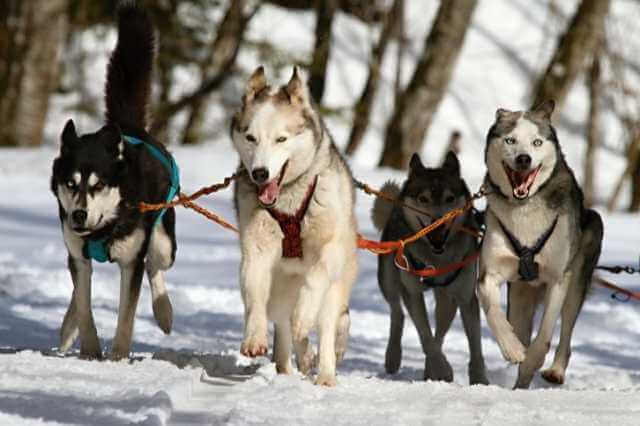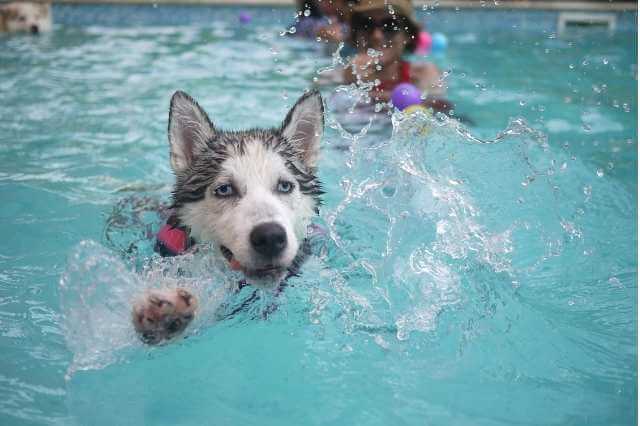There is a lot of discussion going on on this subject.
Is it OK for huskies to live in Texas? Some say “yes,” but others assert that the region’s hot, muggy weather makes it impossible for huskies to live.
This post will examine both arguments and allow you to make your own decisions.
Table of Contents
Is It Bad for Huskies to Live in Texas?
In Texas, huskies may coexist quite well. Although huskies prefer cooler climates, they are incredibly adaptive and can survive the Texas heat if we give them a little assistance.
Many owners are worried and want to do it the correct way, so it makes sense that they might wonder if it’s good to keep their dogs in an area with a lot of heat.
The short answer is yes if the owner is prepared to go above and beyond to keep their husky secure, cool, and comfortable.
In Texas and other hot places like Florida and Southern California, Siberian huskies are really one of the most well-liked breeds. So, to put it simply, huskies can live perfectly fine in Texas.
However, Texas’s temperature is rising each year, according to experts.
Therefore, more care is needed for your dog to live a better life.
As long as the owner makes sure their husky is secure and cool, which is readily achieved with various techniques and methods, the temperature doesn’t really matter.
As someone who has worked with huskies for more than ten years, I am more familiar with those who live in warm areas than those that are cold, and every husky I have encountered in warm climates—even tropical ones—is content, secure, and totally loving life.
I believe that the idea that huskies “require” cold temperatures is rather unfounded.

Obviously, huskies enjoy the cold, and there’s no disputing how much they enjoy playing in the snow, but don’t worry—they can also adapt to warmer climates.
In Texas, Is It Safe to Leave a Husky Outside in the Summer?
If they have access to water and shade, huskies can handle the heat fairly well.
However, it’s important to gradually get them used to the heat and never keep them outside alone for long periods of time.
Stick to short runs or walks during the summer and steer clear of hard exercise.
Always keep a careful eye on your dog’s body language to spot overheating symptoms like excessive panting or drooling.
Get your husky to a cool area right away if he starts to overheat, and give him some water to drink.
Even in Texas, you may enjoy the summer with your husky at your side if you use prudence and common sense.
What Is Temperature Range Acceptable for Huskies?
Siberian Huskies, like people, can withstand heat to a certain degree. Above that, health problems begin to develop.
Heat stress affects Siberian Huskies more severely than it does humans because of their hyperactive personality and thicker double coat than most other canines.
It’s much hotter for them when it’s hot for you.
Siberian Huskies can generally endure temperatures up to 90°F with proper water and sheltered areas, just like other dogs.
The good news is that much of Texas doesn’t experience average temperatures higher than 90°F.
You’ll have to put up with an average annual temperature of 80°F.
You shouldn’t worry about adopting a Siberian Husky unless you live in a dry desert with no water or shade.
Husky Overheating Warning Signs
It’s crucial to watch out for indications that your Husky is overheating when the temperature rises.

Here are a few symptoms of overheating:
- Collapse: A medical emergency occurs if your husky collapses. If not treated right away, it is the last stage of heat stroke and can be deadly. Contact your veterinarian or the closest emergency clinic right away if your Husky faints.
- Wet fur: Huskies have a thick, double layer of fur that acts as extra insulation from the cold. This fur may, however, also absorb heat. They are overheated if their fur is damp, and they are panting a lot.
- Heavy panting: Huskies pant heavily as a means of cooling down. When kids are playing or exercising, it frequently occurs. However, if they are panting a lot, it can be too hot outside. If they begin to slow down, have more saliva, or breathe with their mouths open, you will know it is excessive.
- Glazed eyes: Heat stroke may be the cause of your husky’s glazed or watery eyes. The heat and relative lack of moisture in their bodies cause the blood vessels in their eyes to dilate more. The eyes will appear sunken in and dry.
- Lethargy or frailty: If your husky is overheated, they may become lethargic and exhausted. It is brought on by a deficiency in brain oxygen. It could want to rest more frequently rather than play or exercise. The gums might also seem white or pallid.
- Drooling excessively: Huskies generally drool when they’re happy or nervous. On the other hand, if they are drooling a lot, it could be an indication of heat stroke. Drool may be viscous, sticky, and have a faint bloody tint.
- Tongue that is brightly colored red or blue: A bright red or blue tongue is another indicator of heat stroke. It happens when the heat expands the blood vessels in their tongue. The blue tongue is a result of low oxygen levels in their blood.
- Vomiting or diarrhea: These symptoms might also indicate heat stroke. It is brought on by their body losing fluids and their intestines drying out. But it also depends on the specific husky. Some huskies may wait until their body temperature reaches beyond 106 degrees Fahrenheit before vomiting or experiencing diarrhea.
- Increased heart rate: You may check to see whether the Husky’s heart rate has increased by taking their pulse. A husky’s heart beats normally between 120 and 140 times per minute. They are overheated if their heart rate is more than 140 beats per minute.
If you see any of these signs, act right away to cool your dog off.
Move them into a shaded or air-conditioned place and provide them with fresh water.
Find immediate medical attention if your dog’s fever keeps rising.
With the right treatment, the majority of dogs will recover from heatstroke without any long-term complications. But it’s always preferable to err on the side of caution.
Therefore, err on the side of caution and take measures to cool your dog down if you’re unclear whether they’re too hot.
Some Advice on Avoiding Dehydration and Overheating
In order to keep your husky healthy throughout the summer heat, there are a few simple hacks and ideas. These are listed below:
Shaded Locations: If you are outdoors in the heat, wherever you may be heading, you need to ensure that your husky has a place to go to get out of the sun. You only need to make sure your husky gets protection from the hot sun, whether it’s a tent or a large tree.
Water Activities: A fantastic method to give your husky a chance to cool off during the summer heat is to take them to a site (such as the beach, lake, or river).
Cool, fresh water: Having fresh water available is one thing, but let’s make sure it’s also very cold. Humans find cold water to be quite refreshing, and your husky feels the same way!

Millions of people absolutely dream of owning a husky. Fortunately, if you desire to reside in the wonderful state of Texas, your dream is not put on wait.
You should spend some time doing further study and considering obtaining a husky for your family, in my opinion.
What Time of Day Is Ideal for Walking and Exercising Your Husky?
If you already own a husky, you are aware of how destructive they can get if not given enough exercise each day.
It might be difficult to find safe times to walk your husky in the sweltering summer heat, so this is something to keep in mind.
You will have to be particularly careful to take your husky for walks in the early morning or late at night.
You’ll experience lower temps at both of these periods, and your husky will be able to let off some steam.
Your husky will immediately let you know if you start to fall behind in giving them walks by acting more destructively or becoming agitated.
Frequently Asked Questions
Should I Shave My Husky in the Summer?
It’s difficult to say! On the one side, shaved huskies are less prone to get parasites like ticks and other dangerous ones.
On the other side, a bushy tail might help your husky stay cool during the heat.
Before deciding whether to shave your husky, it may be advisable to speak with your veterinarian or a support group for husky owners.
How Do Huskies Stay Cool in Texas?
In the summer, Houston, Texas, has an average temperature of roughly 101 degrees Fahrenheit.
This implies that in order to remain cool, Huskies must pant and perspire.
They also wear loose-fitting jackets to allow air to flow freely and prevent rapid heat exhaustion.
What Makes Huskies Enjoy the Cold?
Originally developed in chilly, northern regions where it frequently snowed, huskies are a breed of dog.
As a result, these dogs were built to resist below-freezing conditions.
Huskies are unusually well-furred, which keeps them warm and shields them from the cold surroundings.
Additionally, when it’s cold outdoors, their thick undercoat keeps them warm.
Even while running great distances or engaging in strenuous physical activity outdoors in bitter cold, their muscular build also helps them stay warm.
Due to their amazing endurance and speed on snowmobile tracks, huskies are frequently utilized as sled dogs throughout the winter.
Final Thoughts
In Texas or any other hot place in the US, you may most likely adopt a Husky.
You shouldn’t have to give up the Husky’s love and adoration just because you’re a Texan.
Simply be extra cautious throughout the hot months.
Since you are already cautious around dogs, I have no doubt that you won’t have any issues.

